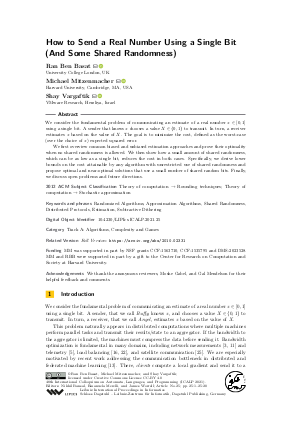LIPIcs.ICALP.2021.25.pdf
- Filesize: 0.88 MB
- 20 pages


 Creative Commons Attribution 4.0 International license
Creative Commons Attribution 4.0 International license

We consider the fundamental problem of communicating an estimate of a real number x ∈ [0,1] using a single bit. A sender that knows x chooses a value X ∈ {0,1} to transmit. In turn, a receiver estimates x based on the value of X. The goal is to minimize the cost, defined as the worst-case (over the choice of x) expected squared error.
We first overview common biased and unbiased estimation approaches and prove their optimality when no shared randomness is allowed. We then show how a small amount of shared randomness, which can be as low as a single bit, reduces the cost in both cases. Specifically, we derive lower bounds on the cost attainable by any algorithm with unrestricted use of shared randomness and propose optimal and near-optimal solutions that use a small number of shared random bits. Finally, we discuss open problems and future directions.


















Feedback for Dagstuhl Publishing